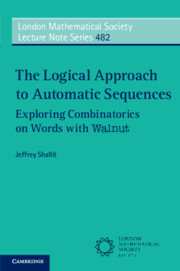Book contents
- Frontmatter
- Contents
- Preface
- Permissions
- 1 Introduction
- 2 Words and sequences
- 3 Number representations and numeration systems
- 4 Automata
- 5 Automatic sequences
- 6 First-order logic and automatic sequences
- 7 Using Walnut
- 8 First-order formulas for fundamental sequence properties
- 9 Regular sequences and enumeration problems
- 10 Synchronized sequences
- 11 Additive number theory
- 12 Paperfolding sequences
- 13 A final word
- Bibliography
- Index
7 - Using Walnut
Published online by Cambridge University Press: 09 September 2022
- Frontmatter
- Contents
- Preface
- Permissions
- 1 Introduction
- 2 Words and sequences
- 3 Number representations and numeration systems
- 4 Automata
- 5 Automatic sequences
- 6 First-order logic and automatic sequences
- 7 Using Walnut
- 8 First-order formulas for fundamental sequence properties
- 9 Regular sequences and enumeration problems
- 10 Synchronized sequences
- 11 Additive number theory
- 12 Paperfolding sequences
- 13 A final word
- Bibliography
- Index
Summary
Walnut is free software originally designed and written in Java by Hamoon Mousavi [278], and recently modified by Aseem Raj Baranwal, Laindon C. Burnett, Kai Hsiang Yang, and Anatoly Zavyalov. This book is based on the most recent version of Walnut, called Walnut 3.7, which is available for free download at
- Type
- Chapter
- Information
- The Logical Approach to Automatic SequencesExploring Combinatorics on Words with Walnut, pp. 96 - 112Publisher: Cambridge University PressPrint publication year: 2022

